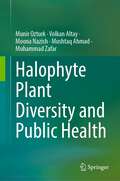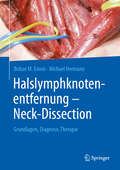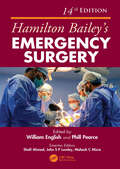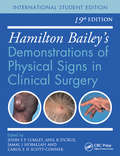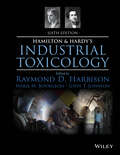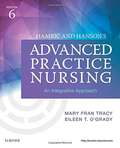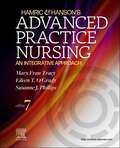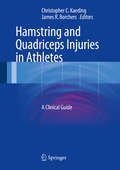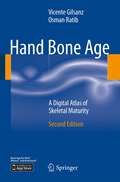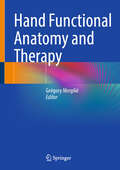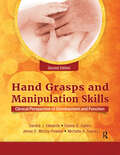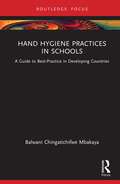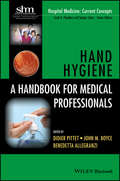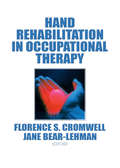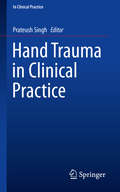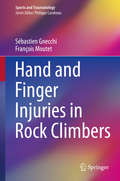- Table View
- List View
Hallucinations in Psychoses and Affective Disorders: A Clinical and Biological Approach
by Alfredo Carlo Altamura Paolo Brambilla Massimo Carlo MauriThis book presents state of the art knowledge on the psychopathology, clinical symptomatology, biology, and treatment of hallucinations in patients with psychoses and affective disorders. The opening section describes and examines the origins of the hallucinatory symptoms associated with schizophrenia, bipolar disorders, and drug- or substance-induced psychoses. In addition, progress in understanding of hallucinations in children and adolescents and chronic hallucinatory disorder is reviewed, and the value of a Research Domain Criteria approach in elucidating the emergence of auditory hallucinations is explained. The biological basis of hallucinations is then closely scrutinized with reference to recent genetic research, neurochemical studies, and functional and structural neuroimaging data. Outcomes of a meta-analysis of diffusion tensor imaging studies regarding the association between white matter integrity and auditory verbal hallucinations are highlighted. The closing chapters focus on the roles of drug treatment and electric and magnetic brain stimulation techniques. The book will be of wide interest to psychiatrists and clinical psychologists.
Hallunications In Clinical Psychiatry: A Guide For Mental Health Professionals
by Ghazi AsaadFirst published in 1991. Routledge is an imprint of Taylor & Francis, an informa company.
Halogenated Heterocycles
by Jernej IskraG. Sandford: Perfluoroheteroaromatic Chemistry: Multifunctional Systems from Perfluorinated Heterocycles by Nucleophilic Aromatic Substitution Processes.- A. A. Gakh: Monofluorinated Heterocycles.- R. Dembinski Y. Li D. Gundapuneni A. Decker: Synthesis of beta-Halofurans.- Y. Shermolovich S. Pazenok: Synthesis of halogenated 5- and 6-membered sulfur- and Sulfur, Nitrogen Containing Heterocycles.- S. Minakata Y. Takeda J. Hayakawa: Heterocyclic Reagents Containing Nitrogen-Halogen Bond: Recent Applications.- Michael Schnürch: Recent Progress on the Halogen Dance Reaction on Heterocycles.- T. Kosjek E. Heath: Halogenated Heterocycles as Pharmaceuticals.- E. Heath T. Kosjek: Sources, Occurrence and Fate of Halogenated Heterocyclic Pharmaceuticals in the Environment.- J. Iskra: Green Methods in Halogenation of Heterocycles.
Halophyte Plant Diversity and Public Health
by Mushtaq Ahmad Muhammad Zafar Münir Öztürk Volkan Altay Moona NazishSalinity is one of the acute problems causing enormous yield loss in many regions of the world. This phenomenon is particularly pronounced in arid and semiarid regions. Halophytes can remove salt from various types of problematic soils due to their unique morphological, physiological and anatomical adaptations to these environments. Halophytes are also used for the treatment of certain diseases but scientific documentation in terms of current phytotherapic applications is deficient in this unique group of plants. Different ethnic groups around the world use medicinal halophytes according to their own beliefs and ancestor’s experiences. However, their knowledge about the use of salt tolerant medicinal plants is usually confined to their own community. There is thus a knowledge gap on halophytes which should be bridged and preserved. This book provides a comprehensive account on the distribution of halophytes, their ethnobotanical and medicinal aspects, economic importance, and chemical constituents along with scientific description. The book therefore serves as a valuable resource for professionals and researchers working in the fields of plant stress biology and ethnobotanical aspects.
Hals-Nasen-Ohren-Heilkunde
by Thomas Lenarz Hans-Georg BoenninghausHNO von A bis Z Von der Audiometrie über die Recurrensparese zum Zenkerdivertikel, der Lenarz/Boenninghaus erklärt Ihnen die HNO in einfacher und sachlicher Sprache. Dabei wird bei der Anatomie und Physiologie angefangen, damit Sie die topographischen Zusammenhänge im Blick behalten. Die manchmal komplizierten Untersuchungsmethoden werden ausführlich dargestellt, die Krankheitsbilder systematisch beschrieben. Fakten lernen mit Zusammenfassung am Kapitelende Fragen und Antworten zu jedem Kapitel Extra Kapitel Leitsymptome und Differentialdiagnosen Gewichtung nach der Häufigkeit im Examen Mehr als 400 Abbildungen Praxis lernen mit Praxisboxen für Famulatur und PJ Zahlreiche Fallbeispiele Fallquiz zum Üben
Halslymphknotenentfernung – Neck-Dissection: Grundlagen, Diagnostik, Therapie
by Boban M. Erovic Michael HermannDie operative Entfernung der Halslymphknoten, auch Neck-Dissection genannt, gilt als fester Bestandteil der Therapie von Kopf-Hals-Tumoren. Der HNO-Operateur Boban Erovic und der Schilddrüsenchirurg Michael Hermann widmen sich in diesem Buch ausführlich der operativen Behandlung der zervikalen Lymphabflusswege. Betroffen sind überwiegend Lymphknotenmetastasen sowohl von HNO-Tumoren als auch von Schilddrüsenkarzinomen. Es wird die standardisierte Lymphadenektomie am Hals aus der Sicht von zwei verschiedenen Disziplinen präsentiert.Nach einem ausführlichen Grundlagenteil zu Anatomie und Diagnostik werden die operativen Schritte einer Neck-Dissection mit den unterschiedlichen operativen Zugängen der HNO- und der Schilddrüsenchirurgie detailliert und mit zahlreichen Abbildungen beschrieben. Das Buch richtet sich in erster Linie an alle am Hals tätigen chirurgischen Disziplinen, aber auch an nicht-chirurgisch tätige Ärzte und medizinisch-technische Berufsgruppen,die mit der postoperativen Nachsorge betraut sind.
Hamilton Bailey's Emergency Surgery
by John S P Lumley William English Phill Pearce Shafi Ahmed Mahesh C MisraThe management of injured and acutely unwell patients remains a cornerstone of surgical practice. Although techniques for assessment, investigation and operative management of the emergency surgical patient may be drawn from elective practice; they also require expediency of decision making and constant consideration of both anatomical and physiological pathology. Hamilton Bailey’s Emergency Surgery 14e is the famous textbook of emergency surgery that defines these key principles.Reflecting huge changes in the practice of emergency and general surgery over recent years, this new edition of Hamilton Bailey's Emergency Surgery is designed to meet the needs of basic and higher surgical trainees. The thorough and diverse coverage of emergency surgical principles including important anaesthetic and physiological considerations and the use of damage control techniques alongside core topics in emergency surgery such as shock and response to injury, surgical infections, principles of wound management and nutrition ensure that the clinician has evidence-based medicine to rely on. The extensive range of trauma surgery chapters cover all the surgical subspecialties as they relate to emergency surgery providing comprehensive coverage of acute care surgery.The new edition of this highly regarded textbook on emergency surgery provides the necessary knowledge and evidence base to help the on-call surgical trainee through the important decision-making process when treating acute surgical patients. In addition to guidance on relevant investigations and surgical techniques, emphasis is also placed on those non-technical skills including leadership and communication which are essential for the management of unwell patients.General surgeons and those working in the emergency setting will benefit from the gold standard expertise provided in the 14th edition of Hamilton Bailey's Emergency Surgery.
Hamilton Bailey's Physical Signs: Demonstrations of Physical Signs in Clinical Surgery, 19th Edition
by Anil D'Cruz John Lumley Jamal Hoballah Carol Scott-ConnorIt is approaching a century since the first edition of Demonstrations of Physical Signs in Clinical Surgery was first published, authored by the pioneering surgical teacher Hamilton Bailey. That it has survived is testimony to the continuing need for those learning surgery to be able to elicit physical signs in the patient and to understanding thei
Hamilton and Hardy's Industrial Toxicology
by Marie M. Bourgeois Raymond D. Harbison Giffe T. JohnsonProviding a concise, yet comprehensive, reference on all aspects of industrial exposures and toxicants; this book aids toxicologists, industrial hygienists, and occupational physicians to investigate workplace health problems. • Updates and expands coverage with new chapters covering regulatory toxicology, toxicity testing, physical hazards, high production volume (HPV) chemicals, and workplace drug use • Includes information on occupational and environmental sources of exposure, mammalian toxicology, industrial hygiene, medical management and ecotoxicology • Retains a succinct chapter format that has become the hallmark for the previous editions • Distils a vast amount of information into one resource for both academics and professionals
Hammertoes: A Case-Based Approach
by Emily A. Cook Jeremy J. CookComprised exclusively of clinical cases demonstrating the various management strategies for hammertoes, this concise, practical casebook will provide foot and ankle surgeons with the best real-world strategies to properly treat these frequent deformities of the lower extremity and their complications. Beginning with a review of the relevant anatomy and biomechanics of the toe, each subsequent chapter includes case material with a unique clinical presentation, followed by a description of the diagnosis, assessment and management techniques used to treat it, as well as the case outcome, literature review and clinical pearls and pitfalls. Chapters included illustrate different surgical fixation techniques, including PIPJ arthroplasty and arthrodesis, tendon transfers and tenotomies, and osteotomies, as well as management strategies for complications. Pragmatic and reader-friendly, Hammertoes: A Case-Based Approach is an excellent resource for foot and ankle surgeons treating this common but frustrating condition.
Hamric and Hanson's Advanced Practice Nursing: An Integrative Approach
by Eileen T. O'Grady Mary Fran TracyEdited and written by a Who’s Who of internationally known advanced practice nursing experts, Hamric and Hanson's Advanced Practice Nursing: An Integrative Approach, 6th Edition helps you develop an understanding of the various advanced practice registered nursing (APRN) roles. <p><p>This bestselling textbook provides a clear, comprehensive, and contemporary introduction to advanced practice nursing today, addressing all major APRN competencies, roles, and issues. It covers topics ranging from the evolution of advanced practice nursing to evidence-based practice, leadership, ethical decision-making, and health policy. <p><p>New to this edition is expanded coverage of inter-professional collaborative practice, updated coverage of APRN roles related to implementation of healthcare reform in the U.S., updated and expanded coverage of IOM and QSEN, a global focus on international advanced practice nursing, and much more!
Hamric and Hanson's Advanced Practice Nursing: An Integrative Approach
by Eileen T. O'Grady Mary Fran Tracy Susanne J. PhillipsEdited and written by a "Who's Who" of internationally known thought leaders in advanced practice nursing, Hamric and Hanson's Advanced Practice Nursing: An Integrative Approach, 7th Edition provides a clear, comprehensive, and contemporary introduction to advanced practice nursing today, addressing all major APRN competencies, roles, and issues. <p><p>Thoroughly revised and updated, the 7th edition of this bestselling text covers topics ranging from the evolution of advanced practice nursing to evidence-based practice, leadership, ethical decision-making, and health policy.
Hamstring and Quadriceps Injuries in Athletes
by Christopher C. Kaeding James R. BorchersInjuries to the hamstring and quadriceps muscles can occur in both low- and high-impact sports and as such are among the more common injuries incurred by athletes. Reviewing the relevant physiology, epidemiology, mechanisms, clinical presentation and treatment of these conditions, Hamstring and Quadriceps Injuries in Athletes covers all sports-related injuries of the thigh musculature in one place. Topics covered include mid substance injuries, acute proximal tendon avulsions and harvesting of hamstrings, as well as strains, contusions and ruptures of the quadriceps, including the use of biologic enhancing agents in healing. Chapters on rehabilitation and injury prevention present techniques to maximize recovery and minimize long-term impairment, speeding up return to play. It will be an often-used and reliable guide for sports medicine practitioners, orthopedists, physical therapists, primary care physicians, team physicians and trainers who treat the injured athlete.
Hand Bone Age
by Vicente Gilsanz Osman RatibIn the past, determination of bone maturity relied on visual evaluation of skeletal development in the hand and wrist, most commonly using the Greulich and Pyle atlas. The Gilsanz and Ratib digital atlas takes advantage of digital imaging and provides a more effective and objective approach to assessment of skeletal maturity. The atlas integrates the key morphological features of ossification in the bones of the hand and wrist and provides idealized, sex- and age-specific images of skeletal development New to this revised second edition is a description and user manual for Bone Age for iPad®, iPhone® and iPod touch®, which can be purchased and used separately from this book. The App can be easily employed to calculate the deviation of the patient's age from the normal range and to predict a possible growth delay. This easy-to-use atlas and the related App will be invaluable for radiologists, endocrinologists, and pediatricians and also relevant to forensic physicians.
Hand Function
by Mehmet Tuncay DuruözAccurate assessment of hand function is critical to any treatment regimen of the hand compromised patient. Hand Function is a practical, clinical book which provides the knowledge needed to distinguish the different dimensions of hand function, particularly impairment, disability and handicap. Beginning with an overview of basic principles and examination, subsequent chapters evaluate the hand function in specific afflicted populations, including the rheumatoid patient, the stroke patient, the trauma patient, the geriatric patient and the pediatric patient, as well as special populations such as diabetes mellitus patients and musicians. An appendix containing hand function scales essential to the assessment of disability is also included. Rheumatologists, physiatrists, hand surgeons, orthopedists, occupational therapists and physical therapists will all find Hand Function a useful and valuable addition to their clinical references.
Hand Function: A Practical Guide to Assessment
by Mehmet Tuncay DuruözThis practical guide aids clinicians in distinguishing the different dimensions of hand function such as impairment, disability, and handicap. New and updated chapters discuss cerebral palsy, sports injuries, robotics, and assistive technologies. Extensively revised, the book provides a broad overview of the basic principles and examination of hand function. It describes how to evaluate hand function in specific afflicted populations, including the rheumatoid patient, the stroke patient, the trauma patient, the geriatric patient, and the pediatric patient as well as special populations such as diabetes mellitus patients and musicians. It also includes an appendix of hand function scales essential to the assessment of disability. The Second Edition of Hand Function is an ideal resource for all rheumatologists, physiatrists, hand surgeons, orthopedists, occupational therapists, and physical therapists caring for patients with impaired hand function.
Hand Functional Anatomy and Therapy
by Grégory MespliéThis book developed from the experience of the ISAMMS team (Institut Sud Aquitain de la Main et du Membre Supérieur), who has been treating hand and wrist pathologies for over 20 years, with the collaboration of experts in their fields. Hands and wrists require specific care from a multidisciplinary staff. The patient has to be treated efficiently from their injury to their returning to work and to sports activities. This third volume covers the functional anatomy of the hand, as well as the most up to date knowledge regarding the surgical and orthopaedic protocols for treating hand pathologies. This publication is intended for physiotherapists and occupational therapists, surgeons and practitioners specialized in physical rehabilitation, as well as for the students in those fields.
Hand Grasps and Manipulation Skills: Clinical Perspective of Development and Function
by Sandra J. Edwards Jenna D. McCoy-Powlen Donna Gallen Michelle A. SuarezHand Grasps and Manipulation Skills: Clinical Perspective of Development and Function, Second Edition is an expertly designed and logically organized text that provides an accurate and clear depiction of the development of hand grasps and the taxonomy of functional hand grasp.Hand Grasps and Manipulation Skills, Second Edition by Sandra J. Edwards, Donna B. Gallen, Jenna D. McCoy-Powlen, and Michelle A. Suarez is full of concise and user-friendly text that is written to assist in understanding complex information. The photographs, illustrations and charts have been expanded in this Second Edition and present new content areas for students and clinicians to use in education and practice.Hand Grasps and Manipulation Skills, Second Edition is unique in that it is also the only text on the market that contains this comprehensive pictorial information about hands and their grasps. Additional unique features include rare information about in utero development of the hand, left handedness, scissor skill development, in hand manipulation skills, and extensive information regarding clinical application. Hand Grasps and Manipulation Skills, Second Edition is a text that can be used as a career long reference. It provides all the pertinent and comprehensive information for students to learn about the development of the hand in one place, and is expertly and thoroughly referenced with the latest research.Hand Grasps and Manipulation Skills: Clinical Perspective of Development and Function, Second Edition provides clear information on a very specific subject, which makes it the ideal reference for occupational therapy professors, students and clinicians; mechanical engineers, computer software instructors, and engineers working in robotics; medical students and orthopedic hand surgeons.
Hand Hygiene Practices in Schools: A Guide to Best-Practice in Developing Countries
by Balwani Chingatichifwe MbakayaThis book provides essential guidance to help schools in developing countries to promote and maintain hand hygiene practices, thus reducing the prevalence of infectious diseases such as diarrhoea and respiratory infection that cause both illness and absenteeism. Discussing both the challenges that hinder hand hygiene practices and the opportunities available to promote positive behaviours, it is particularly timely since the onset of the global Covid-19 pandemic, where infection could also be passed on through the hands. Drawing on both evidence-based research and successful interventions in specific countries, the book builds to offer a best-practice manual to address this important issue. This will be ideal reading for public health and community health working in developing regions, as well as those working for NGO’s.
Hand Hygiene: A Handbook for Medical Professionals
by Benedetta Allegranzi Didier Pittet John M. BoyceThe first comprehensive, authoritative review of one of the most fundamental and important issues in infection control and patient safety, hand hygiene. Developed and presented by the world's leading scholar-clinicians, Hand Hygiene is an essential resource for all medical professionals. Developed and presented by the world leaders in this fundamental topic Fully integrates World Health Organization (WHO) guidelines and policies Offers a global perspective in tackling hand hygiene issues in developed and developing countries Coverage of basic and highly complex clinical applications of hand hygiene practices Includes novel and unusual aspects and issues in hand hygiene such as religious and cultural aspects and patient participation Offers guidance at the individual, institutional, and organizational levels for national and worldwide hygiene promotion campaigns
Hand Injuries in the Emergency Department
by Peter HouptThis new pocketbook introduces students, junior doctors, and clinicians to the vital skills of diagnostic strategy and clinical reasoning for hand injuries. 30% of the patients in an emergency department present with hand injuries or acute non-traumatic problems of the hand. These are rarely life-threatening but can lead to high morbidity and disability due to inadequate diagnosis and treatment resulting in malpractice claims. This book is an easy-to-use ready reckoner for physicians working in ER departments and residents or fellows exposed to hand surgery. It addresses the needs of its core readers and encourages them to refine their powers of observation during physical examination. Key Features:• Presents the content in a comprehensive and logical manner with an appropriate level of illustrations.• Serves as a ready reference of clinical examination in an easy-to-use pocket-book format for residents and physicians who encounter hand injuries.• Covers crucial knowledge in the field of hand trauma.
Hand Rehabilitation in Occupational Therapy
by Jane Bear Lehman Florence S CromwellThis practical book presents the latest and most effective occupational therapy methods and theories designed for treating patients with decreased hand function. The growing incidence of hand injuries in recent years has challenged occupational therapists to develop innovations in hand care. Now, with this authoritative resource, you can greatly enhance your practice skills and ability to plan effective treatment programs. The contributors provide clear examinations of such topics as wound and scar tissue management, the treatment of Colles fracture, and pre- and post-operative approaches to therapy, among many other pertinent areas.
Hand Trauma in Clinical Practice (In Clinical Practice)
by Prateush SinghThis book comprehensively covers hand trauma from initial presentation to management. Material is presented in an easy to follow practically applicable way, bridging the gap between what trainees encounter during training and what is encountered in a busy emergency department . Topics covered include upper limb anatomy, soft tissue injuries and infections, hand fractures, anaesthesia, and referrals from primary care, with detailed guides provided on how to successfully perform techniques such as digit replantation, extravasation, and locoregional flaps. <p><p> Hand Trauma in Clinical Practice systematically describes a variety of categories of hand trauma, and plastic and orthopaedic surgical techniques. Therefore, it represents a valuable resource for practising and trainee plastic surgeons, orthopaedic surgeons, and emergency care specialists.
Hand and Finger Injuries in Rock Climbers
by Sébastien Gnecchi François MoutetThe aim of this book is not only to help climbers and coaches gain a better understanding of medical consultations, but also to offer insights into practical treatment. As regards the medical field, the explanation of the different forces exerted on fingers during climbing allows better assessment of the causes of injuries and can help injured climbers adjust when they return to training. Despite their small size and fragility, fingers are essential in rock-climbing. The publication of this book was motivated by the numerous possible injuries and the required treatments, as well as the desire to connect medicine to this field. Combining scientific and medical research offers a new approach to training and practice. Indeed, promoting cooperation between specialists and coaches for the benefit of climbers can reduce the risk of lesions and improve training.
Hand and Foot Reflexology
by Kevin Kunzbarbara KunzHere's a revolutionary way to fine-tune your relationship with your body, reduce stress, and feel better all over: Stimulate the reflexes in your hands and feet! It's all in this hands-on encyclopedia of personal reflexology information. Here, Kevin and Barbara Kunz (authors of The Complete Guide to Foot Reflexology) bring you their unique self-health approach to wellness. Through reflexology, they teach you how to free and channel your pent-up energy -- and to prevent and correct common health problems. With more than 500 detailed instructions, this book includes: * Why your feet and hands are "important sensory organs," and their "special relationship" with your whole body. * Why reflexology works. * Specially designed pressure and movement techniques that reduce stress and actually alter the body's tension level. Fully illustrated, with step-by-step procedures, for quick and easy application! * Treatment plans for specific aliments, from acne to whiplash. * Stride Replication, the Kunzes' latest program of foot and hand relaxation. * A more in-depth look at body parts and their corresponding areas in the hands and feet -- all conveniently indexed. Whether you are using it as a quick reference or as the basis for further study. Hand and Foot Reflexology: A Self-Help Guide tells you what you need to know about the simple but potent experience of eflexology -- by yourself and for yourself.



